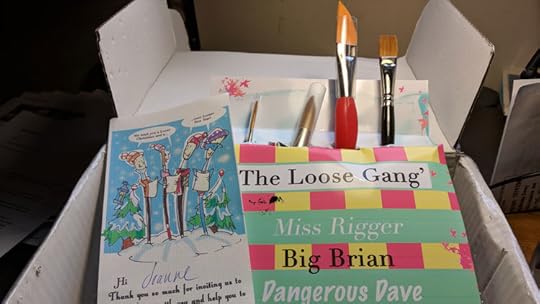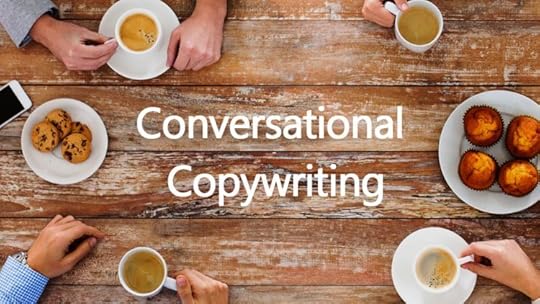Nick Usborne's Blog, page 9
November 2, 2020
Write to people as individuals, not as part of a group.

I’m writing this post for YOU.
We’ve probably never met. But I try to picture you in my mind as I sit at my computer, pecking away at the keyboard.
I might even imagine you here in my home, sitting across from me at the kitchen table.
I’m writing to you as if you’re the only person in the world on my mind right now.
This means I’ll always talk about you in the singular.
One-on-one. You and me.
I think you notice and appreciate it… the fact that I’m writing this just for you.
But what if I stuck you in a group, and wrote to you as part of a crowd?
I could go a different way.
I could say, “As one of my loyal readers, I thought this might interest you.”
There are two things going on here.
First, I’m no longer writing just to YOU. I’ve stuck you in a group of other readers.
Now you’re in a crowd of thousands of other people. Way more than I can fit around my kitchen table!
The dynamic has changed. It’s not one-on-one anymore. It feels different.
Less personal. Less engaging.
Something else happened too.
I called you “loyal”. One of my “loyal readers”.
Ouch.
Now I’m talking like you belong to me in some way. It’s like I own you through having you on my list.
And I’m sitting back, judging who among my readers is loyal, and who isn’t.
I’m on the pedestal, and you’re down there below, invisible within the crowd.
How does that feel?
Not good, I imagine.
For me, that kind of language has me reaching for the nearest unsubscribe button.
You don’t own your readers.
Your readers are busy.
Their time and attention are valuable too. They’re under no obligation to give you even a second of their time.
So… treat them with respect.
Write to each person as if they were the only person in the room, across the table.
Pay attention and work hard to give that person something of value in return for the time they spend with you.
Don’t write to groups.
Write to individuals.
The post Write to people as individuals, not as part of a group. appeared first on Writing for the web - online copywriting and content writing..
August 10, 2020
Traditional advertising starts with, “Just shut up and listen”.

Shut up and listen to that radio ad.
Shut up and watch that TV commercial.
Shut up and read that magazine ad or direct mail promotion.
This is the nature of traditional advertising. It’s one-way.
You’re broadcasting a sales message to an audience that can’t talk back, or
write back.
No wonder advertising is such a hit or miss affair.
No wonder response rates are so low.
Think about it… Nobody likes being told to shut up and
listen.
The arrival of the web opened up two-way conversations…
Discussion lists, forums, comment streams, customer review
sites and more.
The web finally cracked open the door.
People didn’t have to “shut up and listen” anymore. The web gave them a voice, a platform, places where they could be heard.
This came as something of a shock to a lot of companies that didn’t feel comfortable with the idea their audience could now talk back.
Other companies embraced this new reality, inviting
customer feedback and encouraging the use of user-generated content on their
sites.
But still… companies and publishers were still in
control.
They could edit, filter, or turn off much of that feedback, most of the time.
They still wrote “at” their audience.
The web was ready for step two…
Social media gave us the means to enter into true
conversations, and yet…
The growth of social media gave companies a huge
opportunity to truly enter into conversations with their prospects and
customers.
A platform like Facebook has the functionality to help
companies connect with an audience in several ways… from conducting Facebook
Live video events to publishing polls and short surveys… and more.
The potential for interaction and conversations is right
there.
And yet…
Most companies use social media as just one more broadcast
advertising channel.
Visit a company’s Facebook page and you’ll likely see a
ton of promotional posts, and very little interaction from the company in the
comment streams.
Barely social at all.
And a huge missed opportunity.
Will chatbots make a difference?
I’ve been writing websites for over 20 years.
I’ve been writing for social media for over 10.
And now I’m spending more and more time writing scripts
for chatbots.
Chatbot scripts are published on texting apps, like Facebook
Messenger, WhatsApp, SMS etc.
And texting, by definition, is conversational.
Just look at the last texts you shared with a friend, colleague, or family member.
Back and forth. Your turn followed by their turn… and so
on.
That’s how it works for chatbot scripts as well. You
write different pathways for your script so you can respond appropriately to
the input from your users.
When you’re writing chatbot scripts, you’re writing
conversational pathways.
In fact, it’s hard to create a chatbot experience that
isn’t conversational.
If you try to use a chatbot as a one-way broadcast advertising
platform, the experience feels ridiculous.
Maybe chatbots will finally break the broadcast approach to marketing.
I hope so.
I thought social media would break that old-school approach.
But it didn’t. Not really.
I have higher hopes for chatbots, because they just don’t
work unless they’re created as conversations. Back and forth. Taking turns.
Of course, there’s no guarantee that every chatbot conversation created will turn out to be a good conversation.
But at least we’ll no longer be telling our audience to shut up and listen.
(If you’re interested in chatbots and chatbot marketing, you can read more posts on that topic on the Chatbot Forge blog…)
The post Traditional advertising starts with, “Just shut up and listen”. appeared first on Writing for the web - online copywriting and content writing..
February 28, 2020
Short copy rocks.

When I sing the praises of short-form copy, I often get pushback.
Particularly from some of my fellow copywriters.
I’m told that short copy isn’t up to the job.
For the tough jobs… the heavy lifting… only long copy
works.
I’m not so sure.
I think short copy can also get the job done.
In fact, I think some of the most powerful copy is
really, really, short.
Some lessons from politicians…
Back in 2016, when Britain was about to vote on Brexit,
Boris Johnson used three words to make his case…
Take Back Control
Meanwhile, Donald Trump was running a little long with 4
words…
Make America Great Again
Although he did tap into the power of the three-word line
with…
Lock Her Up!
Fast forward to last year, and Boris Johnson won the
election in Britain with…
Get Brexit Done!
Funny thing is… these lines were used to win votes on
issues that were amazingly complicated.
Deciding to leave the European Union is a much more
complex issue than choosing your next coffee maker.
Same with choosing your next President.
But that’s in the realm of politics, not business…
OK. Let me introduce you to a few more really, really, short
lines.
Where’s the Beef?
Got Milk?
Just Do It.
Because You’re Worth It
Think Different
Turns out that short, simple lines have extraordinary
power.
And not just to make an impression, but to drive sales
and change minds.
How many hundreds of millions of dollars do you think were made on the back of “Just Do It”?
And how about being able to change the course of an
entire nation with “Take Back Control”?
Long copy is sometimes lazy copy, or just filler…
There are certainly times when long copy is what you
need.
But I’ll often read long or medium-length copy and think,
“There’s a lot of filler here. A lot of description and explanation that really
isn’t needed. In fact, it’s getting in the way.”
So why do copywriters write long, when short would do
better?
Sometimes we’re just filling the space… like on a
webpage.
Other times we think long copy looks more substantial,
serious or authoritative.
And occasionally, as copywriters, we want to show our
bosses or clients they’re getting their money’s worth.
“Just 3 words? And how much do you want me to pay you for
THAT?”
It takes hard work and courage to write short copy…
It’s not easy to write short, effective copy.
Much easier to write the long, rambling stuff.
But writing short can deliver the most powerful copy of
all.
And in a digital world where we’re writing copy for apps
and promotional text messages, short-form copywriting is becoming an increasingly
valuable skill.
NOTE: You can find out about the various copywriting courses I teach here…
The post Short copy rocks. appeared first on Writing for the web - online copywriting and content writing..
February 7, 2020
5 Simple ways to improve every page of content you create.

We’re all guilty of rushing when writing web content.
Well, I am. And I’m pretty sure I’m not alone!
A 500-word blog post? Maybe I can get that done before my
meeting at 11:00. Or I’ll squeeze it in before finishing up at the end of the
day.
It’s weird, because we rarely think the same about writing
a more “important” page, like a sales page.
But… your content pages ARE important.
Your content is how you broadcast your message and your
value to the world.
It’s how people get to hear about you, and experience
your expertise.
It’s how they learn about your brand, and warm up to your
products or services.
In other words, creating top-level content is central to
success online.
And that’s why we should never rush it.
Here are five tips on how to create better content, consistently.
And you can use the same tips to go back and improve some of your existing
content.
Tip #1: Write a better headline
Again, we’ll spend a ton of time on the headlines we write
for sales pages. But not so much when it comes to content.
That’s a problem, because if you don’t write a compelling
headline, nobody is going to read the body of your content.
Your headline has to stop the reader in her tracks, and
make her know she wants to keep reading.
I have a whole course on how to write better headlines. And I wrote a post on the subject recently.
But for now, here’s a simple tip for you…
The job of the headline is not to tell your story. Its purpose
is to grab attention and make people feel compelled to keep reading.
Tip #2: Make sure the page has a strong beginning and satisfying
end.
If you don’t lose a reader with your headline, you still might
lose him within the first few lines of the body copy.
Remember, people are busy and open to distraction. Particularly
if they’re reading your page on their phone.
So never use the first paragraph or two simply to warm
up.
Way too many writers do that.
Forget the warm-up, and jump straight to the good stuff.
That may take the form of a surprising fact, an amazing
promise or a compelling story. A relatable story, told in a few lines, can be a
great way to engage your readers and get them hooked.
One way or another, make the opening as strong as you can.
And at the end of your page, don’t just fade away.
Draw a strong conclusion. Wrap things up so your readers
can leave with a simple but powerful takeaway.
Maybe give them some new links to follow as well. “If you
enjoyed this post, you might be interested in…”
Tip #3: Make it a multimedia page
It’s not 1998. People aren’t using dial-up anymore.
This means you can add videos and images to your content pages.
This delivers a richer and more attractive experience. It
also helps appeal to different types of learners.
Myself, when I want to find out more about something, or
just keep up with what’s new in any given topic area, I like watching videos.
My wife has no patience with videos. She’ll scroll right
past and start reading the text.
Her biggest complaint is that too many videos start with a
“warm-up” intro, like I talked about in the last tip. Too much blah-blah before
they deliver the good stuff.
A fair bit of my own content opens with a video, followed
by a text version. That way I can appeal to both kinds of learner.
As for images, that’s a great way to add value to your
content. You can show as well as tell.
And, of course, it’s not only your readers who appreciate
a good blend of multimedia. Google likes it too.
Tip #4: Create content that answers your readers’
questions
This tip should come first, in a way. It should certainly
be something you address before you start writing.
Too often we create content calendars based on what we,
as a business, want to say and share.
That can be part of it. But it shouldn’t be all of it.
You shouldn’t focus primarily on what YOU want to say.
You should focus on what your AUDIENCE wants to hear.
Use social media and surveys to ask people what they want
to hear from you. Ask them which topics or questions are on their mind.
Now rewrite your content calendar based on what your
audience wants to hear about.
Do that, and something amazing happens.
They’ll forgive you for a less than perfect headline or
intro. They’ll hardly notice you got lazy with multimedia.
They’ll eat up your content because you’re giving them
the information THEY want to hear about.
That doesn’t mean you should be satisfied with second best.
I’m just trying to make the point that the fastest way to
improve your content is to make sure it’s what your readers want.
Tip #5: Spend twice as long on every page of content
you create
Invest more time on each page of content you create.
Like… five times longer. Ten hours instead of two. That
kind of thing.
Why? Because an OK piece of content will do nothing to
advance your business or your brand.
It will sit on page 5 of the search engine results.
Lonely, and unfound.
You can create a ton of content like that, and see no
real result.
Spend 5 times longer on a single page… a really good page…
and everything changes.
People will talk about it and share it with their friends
and colleague. Great content makes you look good. It makes people want to do
business with you. And Google loves long-form, multi-media content pages as
well.
Instead of dying a slow death on page 5, your post will
now appear on page one of the search results.
Put simply… the more time and thought you put into your
web content, the greater the reward.
Closing thoughts…
Like I said, every page of content needs a close. And a
next step or two.
Here’s the takeaway… however you do it, make sure the
content you publish is the content your audience is hoping for.
And make it better than anything your competitors are
publishing.
Do those two things, and you’re most of the way to the
finish line.
Finally, if you feel inspired to learn more, I teach a full course on Web Content Optimization.
The post 5 Simple ways to improve every page of content you create. appeared first on Writing for the web - online copywriting and content writing..
January 16, 2020
3 Tips on Writing Better Headlines.
Over the years I’ve written a lot about writing
headlines.
I even teach a course on the subject.
But of all the tips I share, I have three favorites.
In fact, these are the tips – or filters – I use myself
when trying to improve my own headlines.
Let’s get started…
Headline Tip #1: Never tell the whole story in the
headline
This is a classic mistake, whether you’re writing a sales
page or a content page, like a blog post or article.
There’s a temptation to give away too much in the
headline.
Here’s an example of saying too much.
“The best country to raise your child is Denmark.”
After reading that headline, I no longer need to read the
rest of the page. You’ve told me the topic, and you’ve given me the answer.
Job done!
The version of that headline I actually found online was
this:
“The best country to raise your child is…”
The topic is revealed, but not the answer. Much better.
Now, if I’m interested in the topic, I’ll keep reading or click through.
Now I’m engaged, intrigued even.
Headline Tip #2: Include a promise of some kind
I like to include some kind of feel-good promise into my
headlines.
Why? Because people like to feel good.
People go to enormous lengths to feel good.
People buy stuff, and services, in search of feeling
good!
That’s why I try to write a positive promise into most of
my headlines.
Like…
“Eat 7 bananas a day and live longer.”
Nice promise there. People want to live longer.
BTW – that line is totally made up. I’m pretty sure
eating 7 bananas a day WON’T make you live longer!
Headline Tip#3: Frontload your promise
My bananas headline is OK. It has a promise. But the real
promise, the most powerful one, is at the end of the line.
Let’s bring it to the front, where it belongs…
“Live longer by eating 7 bananas a day.”
An easy switch, but an important one.
Why? Because not everyone reads the entire headline.
Sad, but true.
So you need to frontload the most powerful benefit, expressing
it within the first few words of the line.
Hang on… I think we just ignored tip number one…
We just told the whole story…
“Live longer by eating 7 bananas a day.”
Ouch.
But don’t worry. This how I write and edit my own headlines.
Back and forth, until I get it right.
Now let’s make a quick tweak, so the reader has a reason
to dive in and read the full page.
“Live longer by
eating 7 servings of this one fruit, every day.”
Hmmm. Mystery. Which fruit? Better keep reading to find
out!
That’s it for now…
There are plenty of other ways to improve your headlines, which is why I wrote an entire course on the subject.
But if all you do is apply the three tips in this post,
you’ll be well ahead of the crowd.
The post 3 Tips on Writing Better Headlines. appeared first on Writing for the web - online copywriting and content writing..
April 16, 2019
4 Ways to earn and maintain the trust of your audience.

Edelman is a communications agency, well known for what
it calls its “trust barometer”.
They track the public’s levels of trust when it comes to
business, the media, institutions and government.
As you can imagine, the results over the last few years
don’t paint a pretty picture. Trust levels overall are down.
Even while people are looking to inform themselves with
the latest news, Edelman reports that 73 percent are worried about fake news
being used as a weapon.
And we need look no further than companies like VW and
Facebook to understand why our trust in companies and large corporations is
being eroded.
So… what is one to do?
Well, there are a few simple steps a company can take to win
back or maintain the trust of its audience.
First, of course, you need to be trustworthy. If you’re
not, then everything else is a lie.
But beyond that, there are important changes you can and
should make to the language you use when communicating with the public.
1. Dump the heavy-handed sales language.
Nothing erodes trust faster than overly-aggressive sales
language.
Think of your least-favorite experience at a car dealership.
Or that evening phone call from a salesperson pitching their latest and
greatest mobile network package.
We instinctively shy away from aggressive sales people.
They trigger our defenses. They make us want to step back.
And, of course, pushy sales tactics simply reinforce our
belief that companies cannot be trusted, because they prioritizes their own
profits over everything else.
If you want to built trust, dial back on the adversarial approach
to marketing communications.
2. Stop using corporate gobbledygook.
While aggressive marketing languages pushes people away, corporate
gobbledygook simply makes your business communications opaque to outsiders.
You know the kind of language I mean.
Lots of jargon. Long, compound sentences. The kind of
text you read and then suddenly realise you have absolutely no idea what they’re
trying to say.
Sometimes this is deliberate. It’s obfuscation. They don’t
want you to understand.
Other times, companies just don’t know any better. They
don’t know how to communicate clearly, and don’t bother to hire writers who can.
Either way, too much gobbledygook will erode people’s
trust in your business. They’ll think you have something to hide.
And if you have something to hide, why would people trust you or buy from you?
3. Communicate in everyday, conversational language.
Far better to write in everyday language.
Like this.
I write in a way that is very close to the way I speak.
Simple ideas. Short words and sentences.
Actually, you’re better off reading my writing than
listening to me speak. When I speak I tend to ramble and repeat myself.
When I sit down to write, I clean things up a lot. I write a few drafts. It still feels conversational, but a lot of work goes into making it sound that way.
And when I get it right, and my writing feels natural, I don’t come over sounding like an untrustworthy company, institution or media mogul.
Everyday, conversational language is disarming and builds
trust.
4. Tell more stories about your customers and employees.
On the subject of being disarming, nothing disarms more
than a good story.
Not a fabricated, “perfect” story.
But a story with real and fallible humans in it.
This could be the story of an employee in a small retail
business who made a mistake, and then made up for it a hundred times over… and
how she did it.
Or the story could take the form of a business case
study.
But again, make that case study real, and human. Share
some mistakes you made along the way.
Nobody trusts perfection.
But absolutely everyone enjoys a good story that’s being
told well.
Bottom line… people trust other people more than they trust companies and organizations.
Edelman has been updating their trust barometer for years
now.
And the trends are not encouraging.
That’s why business everywhere has to turn a new leaf
with their communications and reach out to their audiences in a more open, transparent
and human way.
If you want to some help with that, I have a couple of
courses that fit the bill.
One
course on Conversational Copywriting…
And one on Selling With Stories…

If you found this post helpful, sign up for my e-newsletter and get a free copy of my 35-page guide…
Writing For The Web #1 — 7 Challenges every Writer and Copywriter faces when writing for the Web.
Sign up and I’ll send you the link for the download, and then you’ll receive my most recent post as part of my e-newsletter every Tuesday morning.
Sign Up for my Excess Voice Newsletter…
Name:
Email:
(Your email address will be used only for the purpose of sending you this newsletter, and you’ll be free to unsubscribe at any time.)
The post 4 Ways to earn and maintain the trust of your audience. appeared first on Writing for the web - online copywriting and content writing..
February 18, 2018
My main focus is now on a whole new project and website…
I’ve been writing posts for this site for over 15 years now… and I’ll continue to do so… occasionally.
But for two or three years now I have been spending most of my time on a whole new project and website.
This is a real passion project for me. It’s something I’ve been leading up to for decades.
And it comes with a full-length course.
What’s this new project of mine?
It’s about Conversational Copywriting… check it out…
The post My main focus is now on a whole new project and website… appeared first on Writing for the web - online copywriting and content writing..
I’m now spending a lot of time on a whole new project and website.
I’ve been writing posts for this site for over 15 years now… and I’ll continue to do so… occasionally.
But for a few months now I have been spending most of my time on a whole new project and website.
This is a real passion project for me. It’s something I’ve been leading up to for many years.
And it comes with a full-length course.
What’s this new project of mine?
It’s about Conversational Copywriting… check it out…
The post I’m now spending a lot of time on a whole new project and website. appeared first on Writing for the web - online copywriting and content writing..
January 14, 2018
Every blog post you write needs to finish with a gift. Ribbons too.

Over the last few days I have had the opportunity to read through dozens of homework assignments from one of my courses.
This particular assignment was to write a blog post about foods that are good for brain health.
As always, it was a real education going through everyone’s work. The overall quality of writing was excellent. And it was amazing to see all the different approaches people took.
Different writers showed different strengths.
Some wrote amazing headlines. Some were particularly strong with the introduction, clearly setting up what was to come in the body of the post. Others were strongest when it came to the main part of the post, where they were talking about the health benefits of various foods and food groups.
But…
The group as a whole was at its weakest when it came to writing the concluding paragraphs of their posts.
A few people did a reasonable job with their close, but most let their posts just tail off towards the end.
And in case anyone thinks otherwise… this was entirely my fault.
This is something I failed to teach during the class. For which I apologize. I’ll be sure to include more on this the next time around.
Here’s what I failed to say during the class…
Without a strong conclusion, you’re wasting most of the value of your post. This is true across the board. Doesn’t matter what your topic is. Doesn’t matter whether you’re writing to business owners or consumers.
In this case the post was about the various different foods you can eat that improve the health of your brain in some way, or improve your cognitive performance.
Most of the posts included lists of some kind, with descriptions of various fruits, veggies, berries, fish and so on. And then kind of stopped.
Without a strong conclusion, what does the reader take away?
As a reader who was been through a list of brain-healthy foods, I come out of the end of the post with a memory of having read a really interesting list of foods.
But within the minutes or even seconds, I’ll probably start forgetting items on that list.
The post felt interesting while I was reading it, but has now lost much of its value. I’ve begun to forget it.
But what if the author gave me something at the end I could take away with me?
To illustrate the point, here are some subheads you might use for that last part of the post…
3 Ways to improve your brain health today
Why this matters to your overall health
If you make just one brain-healthy change to your diet, choose this one
How you wrap things up with a bow at the end of each post will depend on the topic and your audience. But do something… don’t leave your reader hanging with no direction.
Finally, here’s something you can do when you’ve finished reading THIS post.
Yep, this is my close.
Go back over the last few posts, articles or other types of content you’ve written.
Now look at the last few paragraphs. Did you wrap things up with a “to-do” item for your readers? Or does the post just fade away?
If you didn’t write a strong close, do it now. Just for practice. That will help you get into the habit of always giving your readers a small gift at the end of every page. With a bow on it.

If you found this post helpful, sign up for my e-newsletter and get a free copy of my 35-page guide…
Writing For The Web #1 — 7 Challenges every Writer and Copywriter faces when writing for the Web.
Sign up and I’ll send you the link for the download, and then you’ll receive my most recent post as part of my e-newsletter every Tuesday morning.
Sign Up for my Excess Voice Newsletter…
Name:
Email:
0 subscribers
We respect your privacy
Email Marketing by GetResponse
(Your email address will be used only for the purpose of sending you this newsletter, and you’ll be free to unsubscribe at any time.)
The post Every blog post you write needs to finish with a gift. Ribbons too. appeared first on Writing for the web - online copywriting and content writing..
November 26, 2017
How Dangerous Dave and Big Brian drive conversations for this artist.

I write and talk a lot about the power and benefits of conversational copywriting.
Today I want to share an example of how the power of conversation extends way beyond just the words we write as copywriters.
Let me introduce you to Dangerous Dave, Big Brian, Flat Phil and Miss Rigger.
As you may have already noticed from the photo above, these are the names of four different paint brushes.
These four brushes arrived in the mail because my wife is an accomplished watercolor artist, but still likes to take classes. And one of the instructors she likes to follow is Andrew Geeson, from Wales. Andrew, as well as being an artist and instructor, clearly has smart marketing skills coded into his DNA.
For his particular style of painting, these are the four brushes he uses. When it became clear his students also wanted the same brushes, he obliged… and began to sell them as a set.
But he also took the unusual step of giving the brushes names… Like Big Brian, Dangerous Dave and so on. As well as being names on the packaging, each brush has the name printed on it.
But that’s just the start.
During his online classes he refers to his brushes by name and, over time, has developed different characters for each. Its seems there’s quite a rivalry between Big Brian and Dangerous Dave. And everyone is a little scared of Miss Rigger.
Andrew even took them with him to Italy this year and shared a photo with his students, showing the brushes “enjoying a gelato” with him at a restaurant.
He’s having a lot of fun… but he’s also driving conversations between himself and his students, and among his students as a group.
He’s telling an evolving story with those brush characters, and he’s making his students part of that story.
His whole approach is playful. It’s enjoyable for everyone to jump in, take part and join the conversation. He is tearing down barriers between teacher and student, and between merchant and buyer.
Most important of all, in my view, is that his idea is inclusive. This isn’t a branding gimmick that he uses to stamp a brand on his business. It’s a discussion point, a conversation piece, an invitation to his students to join in and share the fun.
In fact, inspired by the “gelato” photo, several of his customers have set their own scenes with his brushes, taken photos, and then shared them with the group.
Genius.
And remember, Andrew Geeson is a watercolor artist. He’s doesn’t work for some fancy startup. He’s not a social media marketing guru. And he didn’t hire some high-priced ad agency to come up with this idea. At least, I’m pretty sure he didn’t.
Honestly, I can’t imagine an ad agency ever coming up with an idea like this. And if they did, they’d end up on the front page of industry publications, basking in praise for their fresh and innovative thinking.
My point being that whether you’re a small business owner, a solopreneur or a freelancer, great ideas are accessible to us all.
As you search for that idea… do what Andrew did, and find something everyone can share, talk about and enjoy.
Create a conversation piece that is also an ongoing story… and a story that makes your customers feel they are part of something special.
NOTE: I have an entire course devoted to the craft of Conversational Copywriting. (This link takes you to my Nick Usborne Training website.)

If you found this post helpful, sign up for my e-newsletter and get a free copy of my 35-page guide…
Writing For The Web #1 — 7 Challenges every Writer and Copywriter faces when writing for the Web.
Sign up and I’ll send you the link for the download, and then you’ll receive my most recent post as part of my e-newsletter every Tuesday morning.
Sign Up for my Excess Voice Newsletter…
Name:
Email:
0 subscribers
We respect your privacy
Email Marketing by GetResponse
(Your email address will be used only for the purpose of sending you this newsletter, and you’ll be free to unsubscribe at any time.)
The post How Dangerous Dave and Big Brian drive conversations for this artist. appeared first on Writing for the web - online copywriting and content writing..
Nick Usborne's Blog
- Nick Usborne's profile
- 6 followers





